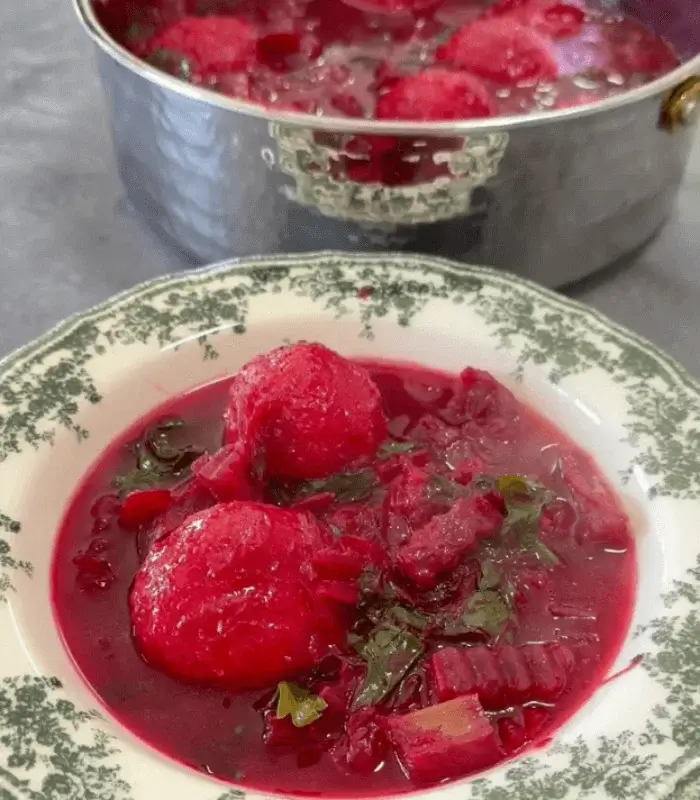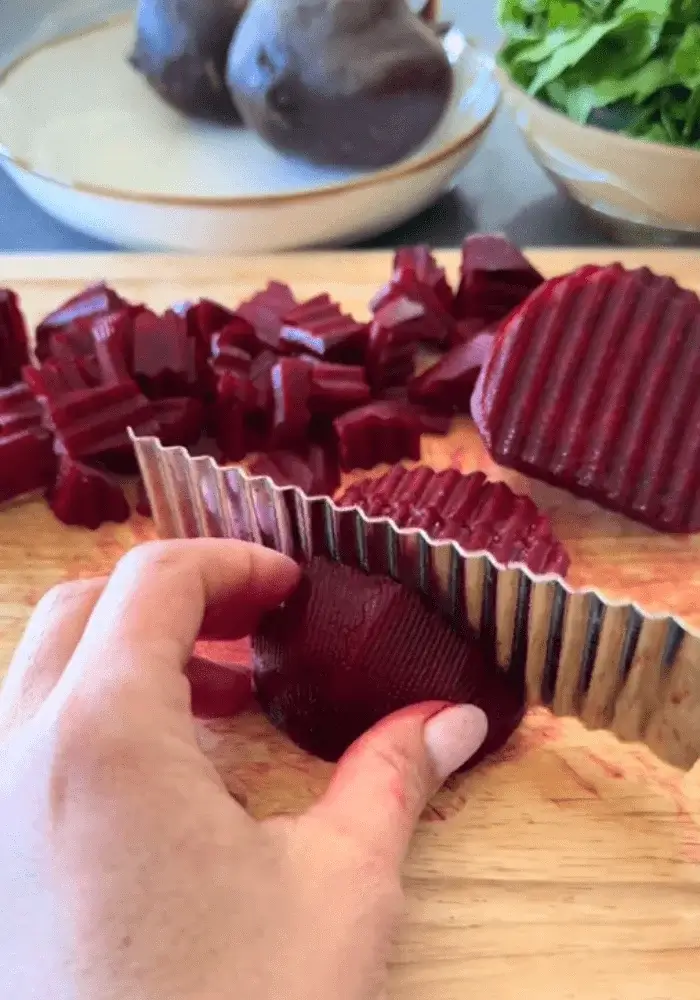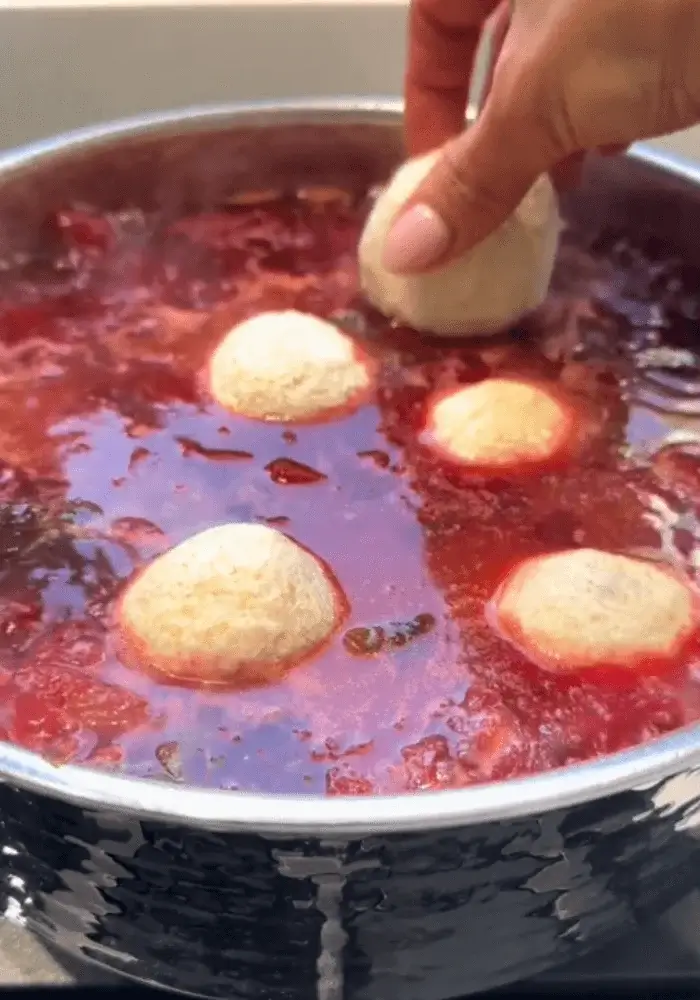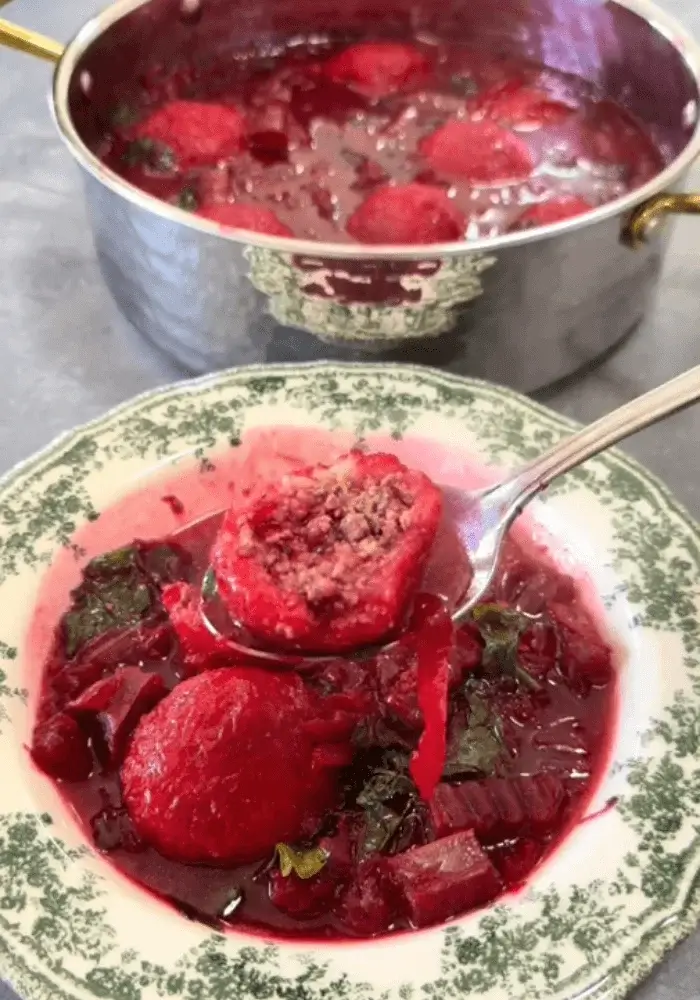Beet Kubbeh Soup
We may earn a commission from recommended products, at no extra cost to you. See Disclosure.
- Large mixing bowl
- Large skillet
- Food processor
INGREDIENTS
- 1½ cups semolina
- 1 cup fine bulgur
- 1 teaspoon salt
- 2 cups warm water
Filling:
- 2.2 pounds/1 kilogram ground beef, preferably from ribs
- 1 large yellow onion, finely chopped
- 1 cup parsley and celery leaves, finely chopped
- 4 tablespoons olive oil
- 1 tablespoon salt
- 1 teaspoon ground black pepper
Soup:
- 1 large onion, finely chopped
- 1 medium beet, peeled and finely grated
- 3 medium beets, peeled and cut into ½-inch cubes
- 1½ cups celery stalks and leaves, finely chopped
- 4 tablespoons olive oil
- 1 tablespoon sugar
- 1 tablespoon salt, plus more to taste
- 1 teaspoon ground black pepper
- Juice of 1 lemon
INSTRUCTIONS
- In a large bowl, combine the semolina, bulgur, salt, and water. Mix until fully hydrated, then knead briefly until a cohesive, pliable dough forms. Cover the bowl and let rest for 30 minutes.
- Meanwhile, prepare the filling: In a large skillet, heat the olive oil over medium heat. Add the onion and sauté until golden and soft, 7 to 10 minutes. Add the beef and cook, stirring frequently and breaking it up with a wooden spoon, until browned and no longer pink, about 10 minutes. Stir in the salt, pepper, and chopped herbs. Cook for 2 more minutes, then transfer to a food processor and pulse until finely chopped. Let cool, then roll into ping-pong–size balls (about 1 tablespoon each). Arrange on a tray and freeze until firm, at least 30 minutes.
- To form the kubbeh, keep a small bowl of water nearby and work with damp hands. Pinch off a piece of dough, roll into a ball, and flatten into a thin disc, about 3 inches wide. Place a meatball in the center, fold the dough around it, and seal tightly. Roll between your palms to smooth into a ball. Trim excess dough if needed. Repeat with the remaining dough and filling. Freeze formed kubbeh until ready to cook.
- To make the soup, heat the olive oil in a large heavy-bottomed pot over medium heat. Add the onion and cook, stirring often, until deeply golden, 10 to 12 minutes. Add the cubed beets and sauté for 1 minute. Stir in the celery, sugar, salt, and pepper. Cook for 2 minutes more to release the flavors.
- Pour in enough water to fill two-thirds of the pot (about 12 cups/3 liters). Bring to a boil, reduce to a simmer, and cook for 30 minutes. Add the grated beet, lemon juice, and frozen kubbeh. Simmer gently for 40 minutes, or until the kubbeh are fully cooked and tender. Taste and adjust seasoning. Garnish with reserved celery leaves and serve hot.

FAQ
How can I freeze kubbeh soup for later?
It’s best to freeze the uncooked kubbeh separately from the broth. After shaping the kubbeh, arrange them on a tray and freeze until solid, then transfer to an airtight container or freezer bag. The broth can be stored separately in a container. When ready to serve, reheat the broth, add the frozen kubbeh directly into the simmering soup, and cook for about 40 minutes. This method preserves the texture and prevents the dumplings from becoming soggy or breaking apart in storage.

Can I use lamb instead of beef?
You can use ground lamb in place of beef in kubbeh soup. Lamb provides a deeper, more robust flavor that pairs well with the earthy beet broth. Choose a lamb cut with a moderate fat content to keep the filling moist but not greasy. Combine it with the same aromatics and herbs as the original recipe. Some cooks also mix lamb and beef for balance. Be sure to cook the meat filling thoroughly and pulse it in a food processor before shaping, as this helps the kubbeh stay intact while cooking.
What can I use instead of semolina in kubbeh soup?
While semolina is traditional and gives kubbeh soup its characteristic texture, you can substitute with fine cornmeal or cream of wheat in a pinch. However, these alternatives may alter the flavor and structure of the dough. If you’re avoiding gluten, gluten-free flours like rice flour or a gluten-free semolina substitute can be tested, though they may require egg or binder adjustments. Keep in mind that semolina helps bind the dough and creates a firm exterior, so replacements should have similar binding properties.
Is it necessary to freeze the kubbeh before cooking?
Freezing helps the dumplings hold their shape and prevents them from falling apart when added to the simmering broth. A 30-minute freeze is usually enough, but they can also be frozen for weeks if stored properly. Adding freshly shaped, unfrozen kubbeh directly into hot soup can cause them to rupture or dissolve, especially if the dough is too soft. For best texture and durability, always freeze before cooking.

Why is the broth in kubbeh soup sour?
Kubbeh soup broth is often sour because of added lemon juice, which balances the natural sweetness of the beets. This sourness is a signature element of many regional versions, especially Kurdish or Iraqi styles. Some recipes also add tamarind or citric acid for extra tang. If it tastes too sour, reduce the lemon or add a pinch of sugar to mellow it. Taste the broth before adding more acid—since the flavors concentrate during simmering, it’s easy to overdo it.
Can I make kubbeh soup vegetarian?
You can make a vegetarian version of kubbeh soup by substituting the meat filling with a mixture of mushrooms, lentils, or spiced mashed potatoes. Sautéed mushrooms with onions and herbs make a flavorful, umami-rich substitute that mimics the texture of ground meat. For the broth, use vegetable stock and enhance it with grated beet, celery, and lemon juice for depth. Make sure to adjust seasoning generously since meatless versions require a bit more attention to spice and salt balance to stand up in the soup.
How do I prevent the kubbeh from falling apart in the soup?
Make sure the dough is properly rested and firm before shaping. Use fine bulgur and semolina in the right proportions and knead until cohesive. Chill or freeze the formed dumplings before adding to the broth. Do not boil the soup rapidly; instead, keep it at a gentle simmer. High heat can cause the dumplings to disintegrate. Also, ensure the filling is finely ground and compact to avoid weak spots inside the dough.

